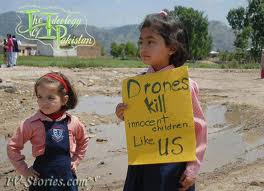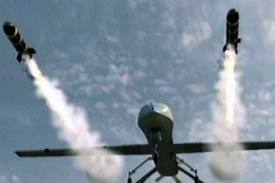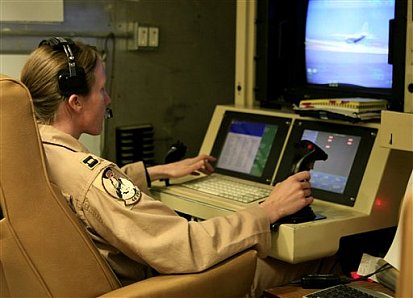By Trudy Cooper
The U.S. is not at war with Pakistan. Yet U.S. drones hover overhead in the tribal regions of North and South Waziristan. Almost daily, there are strikes. Since 2004, these drones have killed as many as 3,000 people in Pakistan. Hundreds more are wounded. Nearly all of them are civilians.
These civilian victims and survivors are human beings, non-combatants, who like most of us, are simply trying to live their lives. They are working the fields, cooking their meals, educating their children. The strikes have destabilized their communities. The people are traumatized both physically and psychologically from fear and grief. The buzz of the drones overhead is never-ending. From the continuous stress, many people have become chronically ill. Women in these areas give birth prematurely. Children are unable to sleep at night as they fear death at any moment from the skies. These communities are helpless to protect themselves. Their residents are unable to move from the area, as they do not have the required skills or education to make livelihoods elsewhere.
What is a drone?
A drone is an “unmanned aerial vehicle.” Drones have been in use for the last thirty years, though few among us have been aware of them until recently. Before the attacks of September 11, 2001, most drones were for peaceful or surveillance use. The more recently developed “Predator” and “Reaper” drones are “weaponized drones,” armed with hellfire missiles. The drones that strike in Pakistan are primarily the Reapers, operated remotely from Creech air force base in Nevada.
Who are the victims?
The US government and the CIA count the majority of the dead and wounded as “enemy combatants.” Headlines from CNN will report, “20 militants killed in North Waziristan.” The method the government uses to define a “militant” is “all fighting aged males.” The presumption is that any male in an area of terrorist activity that is old enough to have facial hair is “probably up to no good.” In other words, they are “combatants until proven otherwise.” There is a wide divergence between the number of dead the US military acknowledges as civilians, and the number that the families from these regions report as civilian dead. The local people and Pakistani research organizations estimate that 95% of the victims have been civilians.
Why is the U.S. bombing its own ally?
This is the question we all need to ask. So far, the question has been posed from sources throughout the world.
In 2008, after four years of strikes in Pakistan, a UN report declared these strikes illegal. Former assistant to the UN secretary-general, Dennis Halliday, called the use of drones “a total violation of international law, the UN charter and…the Geneva conventions.” At the last session of the UN Human Rights Council in Geneva in June, many states called for an investigation into the use of drones.
- Sherry Rehman, Pakistan’s ambassador to the U.S., says that Pakistan has never at any point agreed to the drone strikes.
- The Pakistani government has demanded repeatedly that the strikes stop.
- A Pakistani attorney is suing the CIA for violation of Pakistan’s sovereignty and for compensation to the victims.
- There is a lawsuit by the American Civil Liberties Union and several other organizations within the UK, Pakistan, and the US itself.
Yet, the strikes continue.
What should Pakistan expect for the future?
[pullquote]A First Hand Account of The “Double Tap”
“I heard a massive noise from an attack and all the glass in the house broke…I saw people crying ‘Help us, help us’, there was a huge fire. Since everyone in the [damaged] house was dead or injured, the only people who could help were other villagers…
Many people were badly burned. We put three in my pick-up truck and took them to Miranshah town – doctors there told us they were unlikely to live, each having 90 per cent burns to his body. Back in Danda Darpakhel more people had come to the attack site to help with the rescue, thinking that the danger had now passed after 30 minutes. But the drones returned and fired again. If I had been there I would have been caught in that explosion. People there were killed, including two of my friends. They were good people. One was a student; the other ran a stall at the local bazaar.”
~ Samiullah Khan, Waziristan journalist
Not only do the strikes continue, the U.S. has aggressive plans to expand their use. Over the past several years, drones have become the favored means to fight “the war on terror.” The justification for using these drones is that they protect us. However, Wikileaks cables have revealed that the US government is well aware of the increased terrorism that has resulted directly from backlash, in Pakistan and elsewhere.
So why does this warfare on an ally continue to escalate? Many believe there are four principal reasons: first, the U.S. can suppress and subdue those countries that want to plot their own course, whether toward democracy or toward other forms of rule. Second, by increasing the backlash, radicalization and terrorism within the bombed countries, the US can justify continued occupation of these areas. Third, with a U.S. presence, pressure for conditions that are favorable to the US hegemony can be continuous. Fourth, drone use continues to expand because this is a technology that meets with almost no resistance or objection from the US public.
Why does the US public support the use of drones?
A poll conducted by Pew in 2012 in 22 nations shows that most of the international community condemns the strikes as “barbaric.” But in both the US and the UK, the poll shows that the public overwhelmingly believes the drones are a great advancement toward a “clean and precise” weapon of war. President Obama assures the public that drones are “surgical” and “targeted,” killing only “the bad guys.” More recently, the drones were described at a conference of the American Security Project in Washington, D.C. as “the least horrible choice.” But we have to ask, “For whom?” It certainly is the case that with drone technology, there are no US casualties. The “pilots” of the drones are thousands of miles from their targets. They don’t return to a bunker; they drive to their own homes at the end of the day and have meals with their families. The military recruits their drone operators from high schools. These young people are from a generation that grew up with and excelled at video games.
In fact, piloting a drone takes little more than video game skills. The pilots take one course in how to operate the aircraft by remote control. By contrast, in the UK, a drone pilot must have mastered actual operation of combat aircraft.
The makers of the consoles designed them deliberately to mimic every aspect of video gaming and PlayStation technology. At Creech air force base in Nevada, 19 and 20 year old pilots view surveillance data and live video. They steer the planes and deploy the weapons through use of a joystick. They engage a strike when they see what they think is “suspicious behavior.” One pilot interviewed by Medea Benjamin, author of “Drone Warfare: Killing by Remote Control,” described his job as “boring.” Many hours go by before the drone operators spot a target. This young man described the eventual moment of excitement when they are finally able to make a kill.
When we hear that the drones strike funerals and weddings, we may have the tendency to think, “oh, what a tragic accident, that the pilots misperceived the situation.” But in fact, striking funerals and other gatherings is explicit policy. The policy of the “double tap,” for example, involves waiting until the survivors of the first strike believe the drone attack is over, then returning to hit again. The targets of the second tap are what the pilots term “squirters.” The squirters are those who survived and had fled the scene, but now return, desperate to rescue any people still alive after the first strike. The “pilots” refer to the first-strike victims as the “bug splats.”
[pullquote]Pakistanis believe that Pakistan has little power to stop the strikes other than through public opinion: “We cannot take on the only superpower, which is all-powerful in the world at the moment. You can’t take them on. We are a small country, we are ill-equipped.”
~High Commissioner to the UK Mr Wajid Shamsul Hasan
[/pullquote]To most of us, the term “first responder” would apply to those who go in to rescue the wounded. Instead of “bug splats,” most of us would use the words, “men, women and children.” In fact, according to sources in Pakistan, 95% of the victims were people who were in or outside their homes or in their fields, or perhaps gathered for a wedding or a funeral. One of the larger of the “bug splats” was a gathering in which 60 people died. They were burying the dead from an earlier strike, days before, when they were hit by a missile fired at them from a Reaper Drone. At least ten children and four tribal leaders were among the dead.
A well-known, key feature of objectification is “distance from the consequences of one’s actions.” The young people operating the joysticks in the Nevada desert are 7,000 miles from their victims. They cannot hear their cries or smell their burning flesh.
Do drones produce more terrorists than they kill?
Former top CIA terrorism official Robert Grenier says the US has created “a situation where we are creating more enemies than we are removing.” This reality seems to have been understood by the majority of Pakistanis since the beginning of the drone strikes, in 2004. According to a prominent political figure in Pakistan, Imran Kahn, most of the militants are fighting now not because of ideology, “but because of the collateral damage caused by this war.”
Who Opposes the Use of Drones in Pakistan?
International resistance to the drones is growing. As recently as 2011, there was little discussion of drones. A few months into 2012, activists and human rights attorneys from several nations are coordinating their resistance actions.
The “Creech 14” planned and engaged an action in 2009 at Creech Air Force base in Nevada, the location from which many of the strikes are made. They used their trial as an opportunity to proclaim the duty and obligation of every citizen to take a stand and put a stop to illegal actions by the government.
[pullquote]Join us at the Peace House Fundraiser for the Delegation to Pakistan
- Snacks and socializing
- Drone slideshow & discussion
- Music!
- Maeve Z!
- “General Strike!” (‘fanning the flames of discontent”) http://www.generalstrikeband.com/
- Amento Abioto! http://vimeo.com/44641356
- Silent auction!
We are fundraising for travel expenses for delegate Trudy Cooper.
[/pullquote]The “Hancock 38” included retired Colonel Ann Wright and other nationally prominent peace activists. In April, 2011, they staged a “die-in” at the main entrance of Hancock Air National Guard Base, just outside Syracuse, New York. Like the “Creech 14,” these activists focused on illegality. They argued that they were innocent based on the Nuremburg Principles, which forbids wars of aggression, assassinations, and attacks on civilians—all of which are the signature features of drone warfare. Former Attorney General Ramsey Clark testified that “Drones inherently violate the laws of the United States and international law,” and quoted from Dante’s Inferno: “The hottest places in hell are reserved for those who in times of moral crisis, do not act.”
Within Pakistan, the most prominent figure to organize publicly and loudly against the drones is Imran Kahn, the founder and chair of the Pakistan Movement for Justice Party. This spring, Kahn has organized an international rally and “peace caravan.” Kahn expects to attract 100,000 people, most of them from the region that has been hit hardest by the drones strikes, the Federally Administered Territories (FATA).
The international participants will arrive in Islamabad, and the plan is to march to North Waziristan. Political figures and human rights activists from the UK are expected, as well as a wide range of international media.
What can WE do?
Perhaps the most visible international support that Kahn has attracted is from within the US. The activists from Code Pink, an anti-war organization based in DC, plan to join the rally and march. This group of approximately fifty is led by Code Pink’s co-founder Medea Benjamin.
Many within the delegation are women and men who have children who have served in Afghanistan. Also supporting the trip is Global Exchange, a people-to-people organization that promotes direct ties between citizens of other countries.
Medea and Code Pink were invited directly by the Pakistani organization, the Foundation for Fundamental Rights. Facilitated by human rights attorney Shahzad Akbar, the two delegations will meet with political figures, attorneys representing survivors, and the tribal elders of the communities that are the targets of the strikes.
The US government has so far been unresponsive to its UN, Pakistani, and US critics. The Pakistani people have no one else but us to help expose the horror of the drone strikes. They need us to bring their stories to the world.
Portland’s Delegation—Trudy Cooper & Karen Boyer
From Portland, Karen Boyer and I are attending. On October 3, we will arrive with about fifty others, and will return October 10.
I am honored to have been accepted to represent the concerned people of Portland.
I hope you will be able to come to the fundraiser that the Peace House is holding to help with airfare and other expenses for the trip.
Party & Fundraiser for the Trip
Saturday, September 15, 2012, 6:30 pm
18th Avenue Peace House
2116 NE 18th Avenue
Portland, Oregon
For more information or to RSVP, contact Lisa at lisa@arrivestaffing.com, or call 503-757-1737.
If you are unable to attend but would like to contribute to this effort, you may make a donation at this WePay site: https://www.wepay.com/donations/send-trudy-to-join-the-code-pink-peace-delegation-to-pakistan









